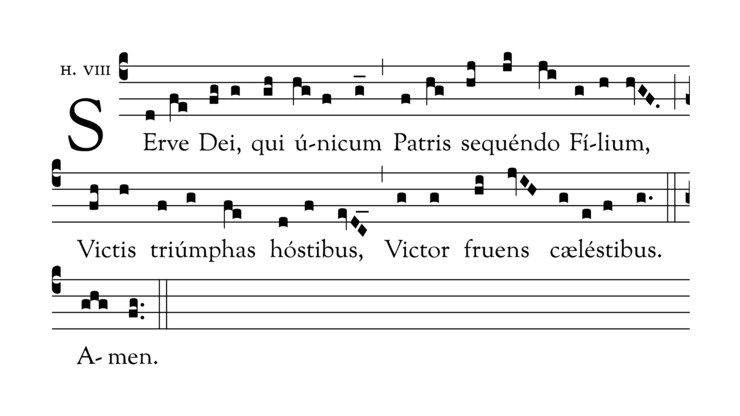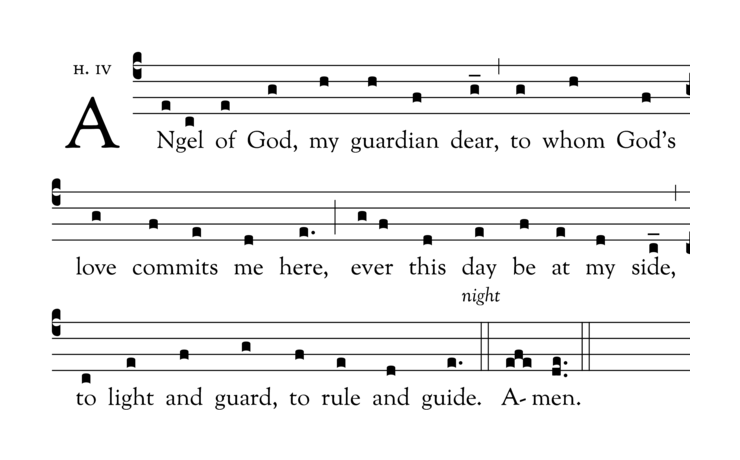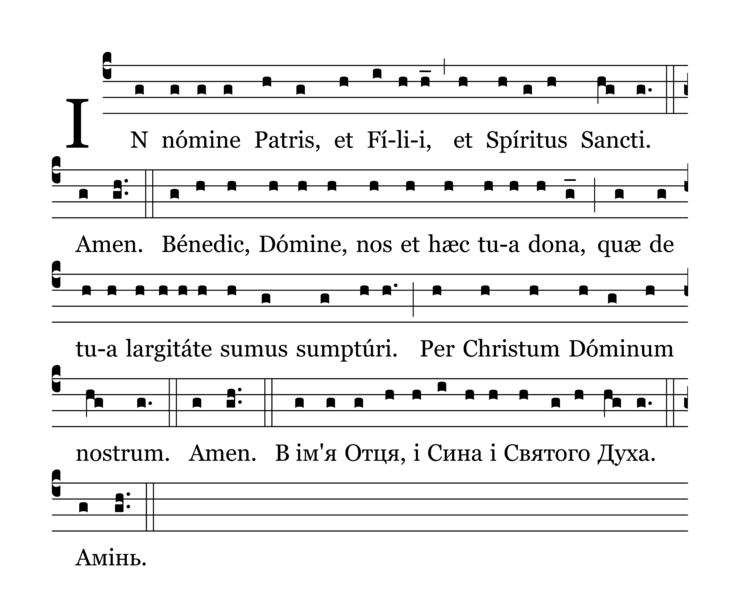Holy Cross Catholic Church
Champaign, IL
5:30 PM
View the worship aid for this appearance
| Prelude | Regnum eius (Graduale Simplex) |
| Offertory | Kyrie fons bonitatis |
| Communion Meditation | Vexilla Christus inclyta |
Holy Cross Catholic Church
Champaign, IL
5:30 PM
View the worship aid for this appearance
| Prelude | Regnum eius (Graduale Simplex) |
| Offertory | Kyrie fons bonitatis |
| Communion Meditation | Vexilla Christus inclyta |
Holy Cross Catholic Church
Champaign, IL
6:30 PM
| Prelude | Requiem æternam |
| Offertory | Domine Iesu Christe |
| Communion | In paradisum |
| Chorus angelorum |
October 6 is the feast of St. Bruno of Cologne, founder of the Carthusian Order.
The Carthusians are famous as by far the most austere Western monastic order. Their motto is Stat crux dum volvitur orbis (“The Cross is steady while the world turns”), and of them it is said that Cartusia nunquam reformata, quia nunquam deformata (“The Carthusians have never reformed, because they have never deformed”).
Most Carthusian monasteries don’t allow visitors who are not discerning a vocation, but the 2005 documentary film Into Great Silence gives a glimpse of their life.
The Carthusians are also famous for one of the world’s great liqueurs, Chartreuse, with which they support themselves. The green variety is the official liqueur of the Sts. Gregory and Romanos Guild.
St. Bruno carefully guarded his humilty by refusing ecclesiastical honor in his lifetime, and the Carthusians honor his choice by not giving him his own hymn in their liturgy. Instead, he gets only the common hymn of a monk. Here is the Carthusian tune for it, transcribed into Roman square notes, with English translation by Percy Dearmer (1867-1936):

2. Tui precátus múnere
Nostrum reátum dílue,
Arcens mali contágium,
Vitæ rémovens tædium.
3. Solúta sunt iam víncula
Tui sácrati córporis:
Nos solve vinclis sæculi
Amóre Fílii Dei.
4. Deo Patri sit glória,
Eiúsque soli Fílio,
Cum Spíritu Paráclito
Et nunc et in perpétuum. Amen.
2. Now join thy prayers with ours, who pray
That God may pardon us and bless;
For prayer keeps evil’s plague away,
And draws from life its weariness.
3. Long, long ago, were loosed the chains
That held thy body once in thrall;
For us how many a bond remains!
O Love of God, release us all.
4. All praise to God the Father be,
All praise to Thee, eternal Son;
All praise, O Holy Ghost, to Thee
While never-ending ages run. Amen.
In my last post I mentioned that my family sings chant as part of our everyday prayer, specifically grace before meals. It’s not the only bit of chant I’ve incorporated into the daily round; we also sing the prayer to one’s Guardian Angel, using the tune for the hymn at Vespers during early Advent, Conditor alme siderum.

The idea is not original to me, coming rather from an old children’s activity book my wife had when she was a girl. I like that the meter of the prayer lets us use a hymn tune rather than one of the liturgical recitative formulas, thus adding a bit of variety.
In case you don’t like gathering around a warm computer to pray (doesn’t everyone? :) ), here’s a PDF for printing it off.
Notre Dame’s Church Life Journal blog has an interesting article on how chant makes the liturgy friendlier for children:
Why Chant is Good for Children
A couple passages are worth noting in particular:
Music in the Roman Rite functions seemingly as an interlude to the actual work of liturgical praise. It’s like, “Hey, it’s getting wordy, let’s sing something to give people a break. Now back to the reading. We’re worshiping God!”
Last Sunday, we went to the Melkite Liturgy on campus. […] Despite our son’s lack of familiarity with the words on the page, he hummed along the entire time (sometimes even during the Eucharistic Prayer). With his slight speech delay, with his limited grasp of understanding of English, the chant allowed him to participate in the Eucharistic sacrifice in a way that he rarely experiences.
I have seen the same behavior out of my children in similar contexts. My mom regularly attends Divine Liturgy at a Ukrainian Greek Catholic parish, despite my family belonging to the Latin Rite, and my children find the chant and ceremony of the Byzantine liturgy as enthralling as Dr. O’Malley’s son did. Likewise, my kids have a great deal of trouble staying focused in the midst of the wordiness of the modern Roman rite. They have certainly improved as they have gotten older and gained greater skill with language, but proper liturgical music still involves them more deeply than any amount of speaking can.
The kids’ behavior when they were younger prompted my wife to postulate the Toddler Test for Good Liturgy: if the liturgy bores the toddlers, you’re doing it wrong.
Outside of Mass, chant is great for involving children in devotional prayer as well. At my house we often pray what we call “Solemn High Grace” before meals, chanted in Latin, with the final Sign of the Cross in Ukrainian because Grandma’s church is cool, and my kids love it. It goes something like this:

A PDF is also available for making printed copies, should you want to try it with your family.
Cathedral of St. Mary of the Immaculate Conception
Peoria, IL
7:15 PM
If you’re on Facebook, follow our Facebook event for more timely updates.
Ad Missam
| Introit | Requiem æternam |
| Kyrie | Kyrie pro defunctis |
| Gradual | Requiem æternam |
| Tract | Absolve, Domine |
| Sequence | Dies iræ |
| Offertory | Domine Iesu Christe |
| Sanctus | Sanctus XVIII |
| Agnus Dei | Agnus Dei XVIII |
| Communion | Lux æterna |
Ad Absolutionem
| Responsory | Libera me, Domine |
Happy Solfège Day! Wait, Happy Nativity of St. John the Baptist! Wait, they’re the same day!
Yes, today we celebrate both the last and greatest of the Old Testament prophets and the musical mnemonic that enabled Julie Andrews to caper about the Austrian countryside.
The Italian monk Paulus Diaconus (c. 720-799) wrote a hymn in Sapphic meter for the Nativity of St. John the Baptist, which was eventually assigned to the canonical hour of Vespers. The first stanza is the key bit (emphases in bold are mine):
Ut queant laxis resonare fibris
mira gestorum famuli tuorum,
solve polluti labii reatum,
sancte Ioannes.
which in English goes something like this:
O for thy Spirit, Holy John, to chasten
Lips sin-polluted, fettered tongues to loosen,
So by thy children might thy deeds of wonder
Meetly be chanted.
A couple centuries later, the Italian monk Guido of Arezzo (c. 991-sometime after 1033) found, or composed, a plainchant tune for this hymn, and he noticed that the first note of each phrase (except the last) made an ascending sequence. He got the brilliant idea to use the corresponding syllables of the hymn text as names for the degrees of the scale, and thus was born solfège:
Ut
Re
Mi
Fa
Sol
La
Do, with its easy-to-sing open vowel, replaced Ut in the 1600s, and Si (from Sancte Ioannes) was added to complete a diatonic scale around the same time. Si became Ti in English-speaking countries in the 19th Century so that each syllable might begin with a different letter.
This evening, then, let us raise our voices to sing Ut queant laxis, and thank God both for Saint John and the ingenuity of our musical forebears.
Ten years ago, the Guild sang at Mass for the first time on this, the feast of the Presentation of the Lord.
We’ve been through many changes since then: singers have come and gone, invitations to sing have ebbed and flowed, the English translation of the Mass was revised, Pope Benedict XVI abdicated, and Pope Francis was elected.
Despite all these changes, our mission remains the same, and we are still committed to serve the liturgy through music, according to the mind of the Church expressed in Article 116 of Sacrosanctum concilium:
The Church acknowledges Gregorian chant as specially suited to the Roman liturgy: therefore, other things being equal, it should be given pride of place in liturgical services.
To celebrate this anniversary, here is a fresh recording of one of the chants we sang ten years ago:
Here’s to another ten years of chant. May God bless us and strengthen us to persevere.
Holy Cross Catholic Church
Champaign, IL
5:30 PM
View the worship aid for this appearance
| Prelude | Rorate cæli |
| Offertory | Ecce virgo concipiet (Communion antiphon) |
| Communion | O Radix Jesse + Magnificat |
| Communion Meditation | Veni, redemptor gentium |
Libera me, Domine
My mother-in-law died at the end of May. She had been ill for many years and was haunted by the memory of things for which she blamed herself, and perhaps by other things for which she was not at fault, but suffered nonetheless. One of her last requests was for a funeral in the Extraordinary Form, and thanks to the generosity of Fr. Scott Archer, Fr. Matthew Deptula, and Msgr. Stanley Deptula, she was buried with the full ceremony of the usus antiquior.
I had sung for many funerals before, but never one in the EF, and while I had the Mass pretty much under control, the burial service was almost entirely new to me. The first responsory at the Absolution quickly became my favorite piece as I practiced:
The mix of terror and hope, the dread in apprehension of the Latter Day mingled with the consolation that the souls of the just are in the hand of God (Wisdom 3:1), seemed to me an appropriate prayer, something that my mother-in-law and I would be comfortable praying together.
Today we pray for all the faithful departed, and that is fitting and just, but if you could spare an extra prayer for Mary Ann Zeilenga, I would be grateful.